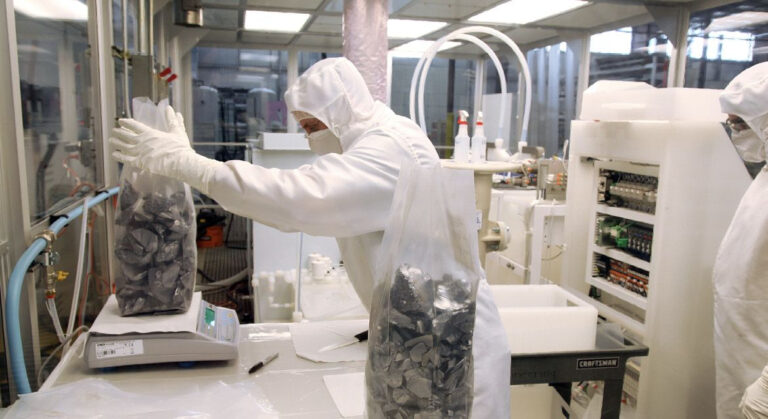Despite the rising rates for imports and an imminent study by the US Department of Trade, the production of polysilicon of the US solar quality is expected to remain the same with the growth of domestic PV-Supply Chain.
From PV Magazine 03/25
The production of the American solar module has grown five -time since the supporting legislation was adopted in 2022. At that time, 70 new facilities for solar energy and energy storage came online and 47 are under construction, according to the Solar Energy Industries Association (SEIA).
Since 2023 manufacturers of solar energy have announced $ 36 billion in American investments, which will create more than 44,000 jobs. Those announcements would yield the total annual solar module capacity to more than 50 GW, plus 49 GW cells, 24 GW waffles and 13 GW Ingot production.
Module -assembly of imported cells has been the first focus, but completely ‘in America’ Zonne -Zonne -Zon would require our polysilicon. The nation today has only two operational polysilicon sites, but the willingness of President Donald Trump to use rates, plus the expected rising demand for PV, could make the production of Polysilicon an attractive proposition.
Seia estimates that the technically challenging development of the Polysilicon production locations requires approximately five years. Marius Mordal Bakke, vice -president for Solar Research at Norwegian consultant Rystad Energy, said REC Silicon’s Moses Lake Fab in Washington State lasted two years and about $ 150 million to restart after closing in 2019. It stops production again to struggle to comply with the purity requirements of the purity requirements.
The largest shareholder of Moses Lake, Hanwha Solutions, ended a 10-year food agreement because of an inability to meet ‘requirements at the right levels’. Hanwha, also the parent company of PV manufacturer Qcells, was planning to deliver his American factories from the facility. Instead, polysilicon from colleague South Korean Business Oci’s Malaysian FAB will be.
REC Silicon, which still produces Silaan gas at Moses Lake, has to hope for alternative Poly Offtakers. “It is possible that they would resume production because the required investment would be much less than starting a new project,” said Bakke.
American stimuli
Michael Parr, executive director of the Ultra Low-Coal Solar Alliance (Ulcsa), said that the production of Polysilicon “has capital for a long time before you have a product.”
The Chinese Polygigant GCL was about the option of American production in 2023. Joint CEO Lan Tianshi said that American production was at least five times more expensive than in China, even taking into account the inflation reduction ACT incentives and legal requirements delay construction. “The American policy is attractive but not attractive enough,” he said.
Germany headquarters in Wacker Chemie and Hemlock Semiconductor are currently the only two American producers of Polysilicon of Solar Poles. Wacker has a site in Tennessee, while Hemlock, owned by Corning Inc. In the US and the Japanese Shin-Eetsu Handotai, a FAB has in Michigan.
The Highland materials from Tennessee in 2024 said it had obtained $ 256 million in “48C” Advanced Energy Project Tax Credits to build a polysilicon site. The location and the expected date of commercial operations must still be announced.
Domestic question
Bakke estimated that the 33,000 tons (MT) of the annual production capacity at the Wacker and Hemlock locations would be sufficient to deliver about 13 GW of solar modules, based on 2.5 grams of polysilicon required per Watt module generation capacity. However, new generation cells can only require 2 grams/W or less thanks to a focus on thinner cells and reducing production waste.
Polysilicon Market Observer Bernreuter Research said that various factors have led to the decrease in polysilicon consumption per cell: reduced waffle thickness, notch loss reduction, rising cell efficiency and use of half-cut cells. The research agency noted that the consumption of polysilicon per gigawatt of PV modulecity in 2023 was only a quarter of what was needed per gigawatt in 2006. Polysilicon facilities in the United States can also increase their production capacity as demand grows.
“If you call the US a market from 40 GW to 50 GW and is 20 GW [of non-silicon based] thin film [solar modules]We have a lot of Western Poly to cover the production of American waffle/cells. “
Rates
President Trump has issued an executive order with an extra rate of 10% of goods from China, effective on 4 February 2025, which means that solar energy sources, including polysilicon, imported from China, are now subject to 60% rates under section 301 of the Chinese Sun Trade Act of 1974. However, it should have little effect on solar prices, because very little polysilicon is imported into the United States and the small amount that comes from Germany and Malaysia.
“For future trade, it would still be cost-effective for newly established American Ingot and Wafer manufacturers to buy Chinese Polysilicon, even with the rate, as long as it meets the UFLPA regulations,” said Bakke, referring to the Uyghur forced Labour Prodio Production of the Import of the Import of the Import of the Import of the Import of the Import of the Import of the Import.
A branch letter from Roth Capital Partners indicated that President Trump could soon initiate a new study on behalf of the American Polysilicon industry to determine the effect of import on national security, a step that can still increase import prices higher. Rystad’s Bakke said the prices for non-Chinese Polysilicon amounted to around $ 18 per kg up to $ 25 per kg. Chinese polysilicon costs just above $ 5 per kg, from February, he said.
This content is protected by copyright and may not be reused. If you want to work with us and reuse part of our content, please contact: editors@pv-magazine.com.


